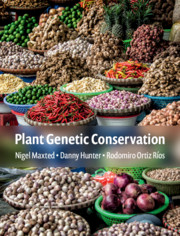Book contents
- Frontmatter
- Frontispiece
- Contents
- Foreword
- Preface
- Acknowledgements
- Part I Introduction
- Part II Scientific Background
- Part III Conservation Practice
- Part IV Plant Exploitation
- 14 Plant Uses
- 15 Germplasm Evaluation
- 16 Plant Breeding
- 17 Participatory Plant Breeding
- 18 Conservation Data Management
- Acronyms and Abbreviations
- Glossary
- References
- Index
- Plate section
16 - Plant Breeding
from Part IV - Plant Exploitation
Published online by Cambridge University Press: 05 September 2020
- Frontmatter
- Frontispiece
- Contents
- Foreword
- Preface
- Acknowledgements
- Part I Introduction
- Part II Scientific Background
- Part III Conservation Practice
- Part IV Plant Exploitation
- 14 Plant Uses
- 15 Germplasm Evaluation
- 16 Plant Breeding
- 17 Participatory Plant Breeding
- 18 Conservation Data Management
- Acronyms and Abbreviations
- Glossary
- References
- Index
- Plate section
Summary
Conserving plant genetic diversity for further use by crossbreeding through various methods for crop improvement is an important goal. Indeed, plant germplasm remains the most important genetic resource for sustaining crossbreeding. Advances in cell and molecular biology enable us to further exploit inter-genera and interfamily variation along with capitalizing on intra-specific and inter-specific variation. Hence, this chapter describes the theory underpinning population genetics and how to use this knowledge for providing a sound and effective strategy and ensuing plan of work for collecting, conserving and using plant genetic diversity. The reader of this chapter will get enough knowledge to identify a suitable crossbreeding method to develop a new cultivar or to improve a breeding line or population and assess the feasibility of using recent advances in agro-biotechnology for transferring new traits into available cultivars or breed new cultivars. This acquired knowledge will allow understanding the basic principles of plant breeding and thereafter use them for crossing and selecting segregating offspring with desired characters.
Keywords
- Type
- Chapter
- Information
- Plant Genetic Conservation , pp. 443 - 468Publisher: Cambridge University PressPrint publication year: 2020

